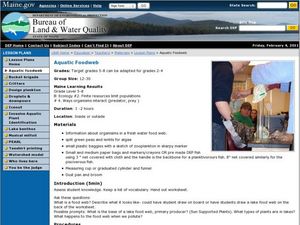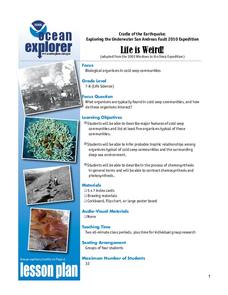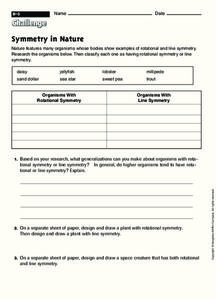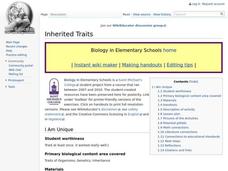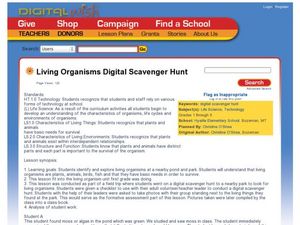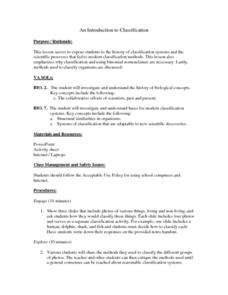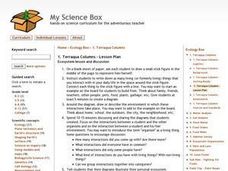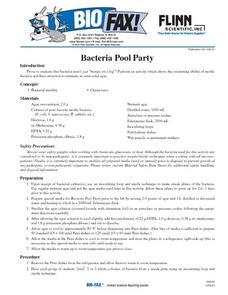Curated OER
Aquatic Foodweb
Students explore what a food web is. In this science lesson plan, students examine how nutrients and other pollutants enter a lake and play a food web game whereby students pretend they are either zooplankton, planktivore,...
Curated OER
Life is Weird
Students describe features of cold seep communities and investigate five organisms that live there. In this biological organisms lesson plan students research a given species and give an oral presentation on their results.
Curated OER
Climate and Temperature
Students explore what the soil temperature would be on the north and south sides of a building. In this temperature instructional activity, students hypothesize what the results will be using a thermometer and then after a week...
Alabama Learning Exchange
Diverse Life Forms of the Ocean
High schoolers recognize marine organisms and differentiate between plankton and nekton. For this investigative instructional activity students create a concept map using their list of terms and study marine life forms.
Curated OER
How Hot is Too Hot?
Fifth graders use the scientific method to conduct experiments on the temperature effects on organisms. In this temperature effects on organisms lesson plan, 5th graders observe and record the hatching or the developing of organisms into...
Curated OER
Symmetry in Nature
In this symmetry worksheet, students put organisms into categories of having line symmetry or rotational symmetry and answer questions about them. Students put 8 organisms into the chart and answer 3 questions.
Curated OER
Biology: Humans as Organisms
Students examine body systems. In this biology lesson, students explore the roles of different body systems and discover the effects of smoking, drugs, alcohol, exercise, and good nutrition on human body systems.
Curated OER
Classification of Organisms
For this classification of organisms worksheet, students use a classification key to identify organisms, then go to a website for help in making up their own classification key.
Curated OER
I Am Unique
Students study traits of organisms including genetics and inheritance. In this genetic traits lesson, students complete a shared reading and discuss the 6 traits of uniqueness. Students sort themselves by specific traits and chart their...
Curated OER
Living Organisms Digital Scavenger Hunt
Students photograph living organisms. In this plan for a field trip, students go to a local park or pond and photograph themselves with various living organisms on their scavenger hunt list. The photographs taken are compiled into a...
Curated OER
Micro-organisms
Learners discuss micro-organisms. In this micro-organisms lesson, students identify which micro-organisms are harmful and which ones are beneficial. Learners complete a worksheet which is included in the lesson.
Curated OER
Ecosystems: Give and Take
In this river ecosystem worksheet, students complete a graphic organizer by writing in what the various organisms lists contribute and benefit in this river ecosystem.
Curated OER
Cell Cycle
In this cell cycle worksheet, students fill in the blank with information about the cycle of a cell. Students sketch several drawings of different phases in the cell cycle.
Curated OER
Viruses
In this virus worksheet, 9th graders study the graph shown that illustrates the sizes of viruses, bacteria, and other structures. Then they state how large a red blood cell is and how large the smallest viruses are that affect plants....
Curated OER
Identifying Organisms
In this organisms worksheet, students explain why scientists use common names to identify organisms and why scientific names are important. Then they describe the characteristics of the bark of a Betula alleghaniensis and how many pairs...
Curated OER
Bacteria in Your Life
In this bacteria worksheet, students describe the process that kills harmful bacteria in milk. Then they describe what types of bacteria are helpful to farmers and which two plants have these bacteria in their roots. Students also name...
Curated OER
Life Processes
Students investigate the basic needs of organisms that must be met in order to carry out life processes. They view a variety of organism that are meeting and competing for resources. Students create an Idea Web for the animals shown....
Curated OER
An Introduction to Classification
Sixth graders explore, analyze and study the history of classification systems and the scientific processes that influenced modern classification methods. They evaluate why classification and binomial nomenclature are necessary to the...
Curated OER
Levels of Organization
Students brainstorm a list of all the functions organisms carry out and how they carry them out. In groups, they are given the smallest and highest level of organization in organisms and are to fill in the missing spaces. To end the...
Curated OER
Getting a Handle on Your Bee
Students observe dried bees, carefully glue them to toothpicks, and use them for cross pollinating their Brassica plants. They also describe reasons why two similar investigations can produce different results. Finally, students...
Curated OER
Terraqua Columns
Learners participate in a discussion about their personal ecosystem and the organisms they interact with on a daily basis. After a discussion, they work in groups to build TerrAqua columns, which they work with for a two to three week...
Curated OER
Bacteria Pool Party
Students investigate the organisms of bacteria. They are given a culture of bacteria that can be observed under a microscope. The students make observations that are recorded. The lesson includes the mention of specific safety...
Curated OER
Great Gravity, Batman!
Eleventh graders are introduced to the effect of gravity on plant growth. They describe the major processes and mechanisms by which plants grow, develop, and supply various products, including energy and nutrition, needed by other...
Curated OER
Bears
First graders investigate the bears of North America that include the grizzly, polar, black, and Alaskan brown. They conduct research on each of these different varieties. The goal is for students to find common characteristics and...


